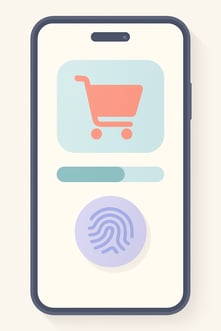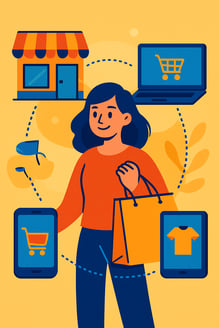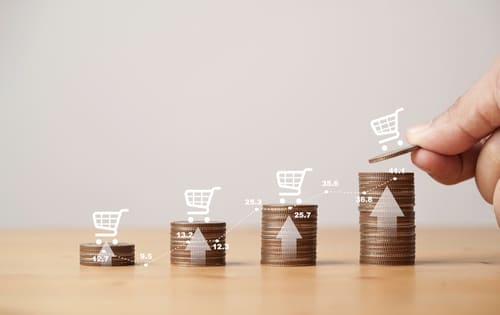Today, there are multiple channels where you can engage with customers and convert the relationship to sales. And ecommerce marketing can offer excellent opportunities to businesses worldwide. When you combine that with the knowledge of current ecommerce trends, you will be ready for the next ecommerce chapter, which includes:
- Create a seamless customer experience across all platforms
- Meet your customers where they are
In this article, we will cover the latest ecommerce trends to watch for that will improve your digital marketing efforts. Let's take a look at the future of eCommerce so you can transform your platform into a conversion powerhouse and stay ahead of the curve.
Buy Now, Pay Later Shopping Trends

Buy Now Pay Later (BNPL) is not new in the world of retail and financing, but with the rise of ecommerce came the digital version of BNPL that serves as an alternative to credit cards, PayPal, and other types of payment. BNPL allows shoppers to buy a product and pay the cost in a predetermined number of installments over a period of time. Gen Z and Millennial consumers are more likely to choose this form of payment method with current BNPL suppliers like Klarna and Affirm.
Online retailers benefit from increased sales from customers who would not have purchased from them otherwise, and consumers get the products they want immediately. Other benefits that Buy Now Pay Later offers to online and offline retailers include:
- It attracts new customers
- It offers a better eCommerce experience
- It leads to higher customer lifetime value (LTV)
.jpg?width=731&height=411&name=unnamed%20(22).jpg)
Serverless Architecture

Originally launched by Amazon, one of the biggest ecommerce platforms, serverless architecture is a way to build and run applications and services without managing the infrastructure. Your information is in the "cloud," and a managed services provider is responsible for ensuring that the servers function optimally. Examples of serverless architecture systems include AWS Lambda, Microsoft Azure Functions, and Google Cloud Functions.
The main benefit of leveraging serverless architecture is cost-effectiveness, as you are not paying for the cost of running the servers. Maintenance is the responsibility of the service provider, and your marketing and design team can focus on improving the customer experience on your website rather than performing maintenance on server architecture. Unfortunately, it's not all positive - workload limitations and security risks are some of the negatives that come with using cloud platforms for an ecommerce website.
Conversion Rate Optimization

In the eCommerce industry, it is not just about getting more traffic but about converting the traffic you do have into sales. Conversion rate optimization (CRO) aims to improve the online shopping experience, whether on landing pages, category pages, or any other customer touchpoint. How can you increase the CRO on your ecommerce platform? Try the following:
- Offer free shipping
- Use high-quality videos and images on your product pages
- Structure your site so customers can easily find what they want
- Provide detailed product descriptions
- Make your checkout process easy to understand
- Regularly test and adapt your ecommerce checkout process
- Let customers know their information is safe in your ecommerce store
- Encourage consumer reviews and testimonials
Conversational Commerce

Another trend is conversational commerce. It is growing within ecommerce marketing and can be used to suggest related products, answer common questions, direct leads, or make announcements. Conversational commerce aims to engage customers in a personalized shopping experience with helpful ways to move them faster through the sales funnel. It can be delivered to a potential customer via any of the following channels:
- Chatbots
- Chat app
- Voice assistant
- Messaging platform
Successful ecommerce brands go where their customers are. WhatsApp, with its nearly 3 billion active users, is one of the ways social commerce can be taken directly to the shopper. Search engine optimization (SEO)-friendly content can be impersonal when done incorrectly. Still, the power of conversational commerce is that it closes the gap between SEO and matching content to user preferences.
Social Commerce Expansion Beyond Facebook/Instagram

In 2025, platforms like TikTok Shop, YouTube Shopping, and even Pinterest are rapidly becoming full-fledged sales channels. TikTok’s algorithm-driven product recommendations make impulse buying nearly effortless, while YouTube’s shoppable videos let viewers purchase products without leaving the platform. For eCommerce brands, this means diversifying your presence—meeting customers on the platforms they actively use, not just the ones you’ve always relied on.
Mobile-first Checkout Innovations
With mobile devices driving the majority of eCommerce traffic, the focus has shifted from “mobile-friendly” to mobile-first checkout experiences. One-click purchasing, digital wallets like Apple Pay and Google Pay, and biometric authentication are quickly becoming default options. The goal is simple — reduce friction so shoppers can go from “I want this” to “order confirmed” in seconds. Skipping this optimization risks losing customers during peak shopping events like holiday sales or product launches.
Generative AI for Product Descriptions, Ads, and Imagery

AI isn’t just personalizing the customer journey—it’s now creating the very assets that fuel it. Generative AI is now producing product views, ad copy, and promotional images in minutes. This lets online businesses react quickly to continued growth opportunities while adopting new technologies to reduce marketing costs.
Hyper-localization

Shoppers increasingly expect experiences that feel custom to their location—and hyper-localization delivers exactly that. It’s more than just translating your site into another language; it’s adjusting product availability, promotions, pricing, and even imagery based on a shopper’s region or city. For global retail brands, this management tools-driven strategy ensures products and services feel more relevant, which can make customers feel more confident in their purchase.
Sustainability Tracking and Proof Tech

Eco-conscious shopping has gone from trend to expectation, but in 2025, customers aren’t just taking a brand’s word for it—they’re looking for proof. Blockchain-powered supply chain tracking, QR codes that show the full journey of a product, and verifiable carbon offset certifications are becoming key purchase influencers. Brands that can show—not just tell—how their operations reduce environmental impact will stand out in a crowded market.
Privacy-first Marketing and Cookieless Tracking Solutions

With third-party cookies disappearing and privacy regulations tightening globally, eCommerce brands are rethinking how they track and target customers. Privacy-first marketing means building trust through transparent data collection and leaning on first-party data strategies, such as loyalty programs, preference centers, and gated content. New tools like server-side tracking and contextual targeting are helping marketers measure performance without violating privacy laws—proving you can still run effective campaigns without invasive tracking.
AI-Powered Personalization at Scale

AI now analyzes browsing history, purchase patterns, and even real-time behavior to instantly adapt what a shopper sees. This means two people landing on the same homepage might have completely different product recommendations, promotions, and content. Platforms like Shopify and BigCommerce have built-in AI tools to automate this process, so even smaller brands can deliver the kind of tailored experience once reserved for retail giants.
Sustainability as a Sales Driver

Shoppers—especially Gen Z and Millennials—are factoring environmental impact into their buying decisions more than ever. Eco-conscious packaging, carbon-neutral delivery, and transparent supply chains aren’t just “nice extras” anymore; they can be the deciding factor in a purchase. Brands that communicate their sustainability efforts clearly and back them up with certifications or measurable actions are winning trust and loyalty. In other words, being green now directly impacts your bottom line.
Subscription & Membership Models

Subscriptions aren’t limited to monthly boxes anymore. In 2025, brands are building membership models that offer exclusive perks like early access to new product drops, free returns, bonus content, or community spaces for loyal customers. For retailers, this means predictable revenue and deeper customer relationships. For shoppers, it’s about convenience and the feeling of belonging to something more than just a transaction.
Voice Search & IoT Shopping

Smart assistants like Alexa, Google Assistant, and Siri are turning spoken requests into purchases—sometimes without a screen ever being involved. Paired with Internet of Things (IoT) devices, this tech can handle everything from reordering laundry detergent through a connected washing machine to adding groceries to your cart via your smart fridge. As the technology improves, voice commerce is becoming a faster, more natural way for customers to shop.
Visual Search
Typing a description into a search bar is giving way to simply snapping a photo. Visual search tools like Google Lens and Pinterest Lens let shoppers upload an image and instantly find similar products available for purchase. This is especially powerful for fashion, décor, and lifestyle brands, where “shop the look” moments can convert inspiration into sales in seconds. For eCommerce stores, optimizing product images and metadata for visual search is becoming just as important as traditional SEO.
Headless Commerce
Content management systems (CMS) are a standard tool in digital marketing. Traditionally, CMS organized content in webpage-oriented frameworks, making it difficult to use the same content for other digital platforms or software. Evolving digital channels and devices require a more flexible content management system, resulting in headless CMS.
A headless system is any type of back-end content management system where the content repository (body) is separated from the presentation layer (head). This way, the content stays in one place but can be used across any front-end. Headless CMS is key to omnichannel strategies and allows businesses to improve their platform's performance quickly by adapting to consumer demands, traffic spikes, or increased sales volume.
Livestream Shopping
The latest ecommerce shopping trends involve social commerce and live-stream shopping. Remember when we used to spend hours watching the Home Shopping Channel? As with Buy Now Pay Later, live shopping is the digital version of an old, familiar shopping experience—but now, video is taking over from television! Supporters of shoppable livestreams say they prefer engaging with products via video rather than pictures. And with the pandemic, it has become a safer way to shop that is also very convenient because you can buy from the comfort of your home.
How does it work? Basically, shoppers interact with a presenter (often a social media influencer) in real-time via a video livestream event. Shoppers ask questions and get to see how the presenter interacts with the product being sold.
Why should you use shoppable livestreams? Livestream shopping showcases your products where your customers interact online. And they link directly to a brand's eCommerce platform, thereby driving sales.
Augmented Reality (AR & VR)
A trend that is leading in the metaverse is augmented reality. Before we discuss how augmented reality is used in ecommerce, let's clarify the difference between augmented reality (AR) and virtual reality (VR):
- Virtual reality (VR) uses computer technology to create a simulated environment.
- Augmented reality (AR) simulates artificial objects in a real environment.
How does augmented reality support an ecommerce site? This allows customers to preview products and experience services in their own environment before they make an online purchase. It bridges the gap between shopping in-store and shopping at an online store.
How is ecommerce using augmented reality?
Virtual try-on. Customers use an application to see if clothes will fit.
Preview placement. An application is used to place a piece of furniture in a photo of the customer's living room.
Interactive user manuals.
Social media filters. As seen on Instagram Stories and Snapchat.
Omnichannel Shopping Experience
The omnichannel experience is all about being where your customers are. Whether you use paid advertising such as pay-per-click (PPC) to engage them on Google or any of the social media platforms, customers expect to engage with their favorite brand everywhere. And they want to move seamlessly through the omnichannel shopping experience.
The customer journey used to be simple: you would go to a brick-and-mortar store and buy what you wanted. Now, people can physically be in the store but at the same time also be on the brand's social media page to make a purchase that is delivered to their home. They can make a decision after looking at the product reviews on a website and chatting with their friends about it. Ultimately, customers want to move easily between platforms and devices when shopping, and ecommerce businesses must keep up.
B2B Ecommerce Trends to Watch for
B2B allows buyers to do purchase research online rather than from a salesperson. This means that tasks like managing money (paying and getting paid), ordering more stock, and delivering products are becoming automatic. If you sell things to other businesses, it's important to keep up with the latest ecommerce industry trends.
Ecommerce technologies linked to cloud computing and storage, search engine optimization, and predictive analytics are shifting from being optional to essential. Additionally, advancements have enabled personalized offerings such as products, promotions, checkout experiences, marketing messages, and price adjustments. This facilitates B2B businesses in tailoring pricing to individual customers and circumstances, improving sales operations in the process.
Key Takeaways for the eCommerce Market: Stay Ahead of the Curve
The eCommerce space in 2025 is defined by rapid tech adoption, shifting customer expectations, and the need for agility. To stay ahead, focus on these core actions:
- Diversify your sales channels— Expand beyond Facebook and Instagram into TikTok Shop, YouTube Shopping, and Pinterest to meet shoppers where they already spend time.
- Prioritize mobile-first shopping—Implement one-click checkout, digital wallets, and biometric authentication to remove friction from the purchase process.
- Leverage AI creatively—use generative AI to produce product descriptions, ad copy, and imagery at scale while maintaining brand voice.
- Think local, act global—implement hyper-localization to adapt offers, pricing, and promotions to different regions for higher engagement.
- Show proof of sustainability—use blockchain tracking, QR codes, and verified certifications to demonstrate environmental responsibility.
- Plan for a cookieless future—build strong first-party data strategies, like loyalty programs and preference centers, to continue personalizing without invasive tracking.
- Deliver personalization at scale—implement AI-powered recommendations and content adjustments in real time for every shopper.
- Invest in emerging experiences—adopt AR/VR tools, livestream shopping, and voice commerce to connect with customers in interactive, engaging ways.
- Streamline operations—Explore serverless architecture and headless commerce to keep your platform fast, scalable, and adaptable.
eCommerce Growth Trends Shaping 2025
The growth in ecommerce is expected to reach new heights in 2025, with projections estimating a significant increase of nearly 9% from 2023. This is due to the rise of mobile shopping, the increased adoption of social commerce experiences, and a growing emphasis on personalization and customer experience.
WSI is a digital marketing agency you can trust. We have an extensive network of industry thought leaders that keep our clients' solutions fresh and relevant. WSI has also twice been named Top Agency by the Web Marketing Association (WMA). We take pride in our knowledge and expertise. Do you want to work with us or need more information on eCommerce trends? Then speak to an expert today.






